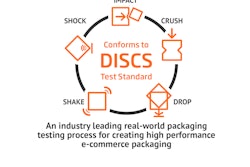There are number of estimates being bandied about the industry relating to how quickly e-commerce sales will grow over the next several years; they range anywhere from 8% to 16%. Whatever the number, it’s clear e-commerce will be the biggest driver of retail sales for the foreseeable future. After all, the most optimistic of forecasts for brick-and-mortar sales growth top off at 3%.
As a brand owner or co-packer, do you have a strategy in place to capitalize on this growth? In a January 2017 webinar hosted by IoPP (Institute of Packaging Professionals) and the Contract Packaging Association, Matt Dingee, Co-founder, President, and COO of OnPoint 2020 Packaging Insights and Consulting Services, provided “A Contract Packaging Playbook to Win E-Commerce.” His presentation included insights on the four dimensions of e-commerce, as well as four “power plays” to help businesses expand their e-commerce services, embed e-commerce into their brand strategies, and meet the technical challenges that may arise.
The four dimensions of e-commerce
According to Dingee, there are four e-commerce dimensions—speed, weight class, e-commerce channels, and consumer experience—each of which needs to be considered when developing an e-commerce strategy. “E-commerce has a digital and a physical component,” he said. “And those are the threads that tie together in each of the four areas, as I classify them.”
Speed: Speed in e-commerce includes delivery speed, speed of supply chain, and speed of communications. With e-tailers like Amazon Prime and Walmart offering two-day shipping, consumers now have the expectation that when they buy something online, delivery will be fast. “And if it’s not fast, then you certainly better be offering something like free shipping, so at least they are getting some value that way,” advised Dingee.
Speed of delivery depends on the speed of your supply chain, how fast you can mobilize your operations, from the time a consumer clicks on the order until the time it arrives and they are “unboxing” it. Consumers now also want speed of communications, with updates on when an order has been logged in to the warehouse, when it’s been processed, and when it will arrive on their doorstep. “It might seem like communications overload, but they love receiving these updates,” said Dingee. “They feel like it’s a service that the brand, or the retailer, is providing.”
Weight class: Unlike traditional CPG goods distribution, where freight is measured by truckload, less-than-truckload, or pallet, e-commerce involves the miniaturization of freight. “When you think of the weight class of e-commerce, you’ve got to think of it as being miniaturized down to the delivery unit, and it’s at this level that the shipping and freight are calculated,” said Dingee. That calculation is now based on dimensional weight (DIM), where carriers have determined the rules around what something should cost based on dimensional calculations. For the brand owner, it involves creating the most efficient shipping unit, based either on DIM weight or physical weight. Dingee says companies that can work within the rules and use them to their advantage will be the ones that win in the end.
E-commerce channels: While many consider e-commerce one channel, it is made up of many specialized channels. Among them are club and bulk channels, such as Boxed.com—essentially an online club store; online retailers, such as Amazon and Jet.com/Walmart, that collect various brands and ship them; direct subscriptions, where the brand has their own direct payment method and storefront and ships directly to the consumer; affiliate packs, where different brands market complementary products on one website; and meal kits, where a company portion-packs meal ingredients and delivers them to the consumer. One e-commerce/retail hybrid is the grocery delivery/pickup model, where consumers order groceries online and then pick them up at the store.
“Knowing the different online delivery and business models will really influence how you design packaging,” said Dingee. “You can’t just plug in one type of package and think it will work for everything.”
User experience: User experience is becoming king—from the very front end to delivery, unboxing, and use of the product. E-commerce involves a much more intimate relationship with the consumer than traditional retail. Said Dingee, “You know what they are looking at and what they are ordering, so you are able to surprise and delight them with the product in the shipping case during unboxing”—a significant part of the consumer experience, as 20 million-plus YouTube unboxing videos will attest.
Another component of the user experience is their “free shipping obsession.” The challenge is to build that into your e-commerce strategy so you are delivering value to the consumer through free shipping, but also offering products at a proper price, Dingee notes.
The four power plays
Using the analogy of the movie Rocky, Dingee asked listeners to consider whether they are Rocky, the one who is competing in e-commerce as a brand, or Mickey—a trainer in the form of a contract packager, a fulfillment center, or a thought leader. For both fighter and trainer, he provided four plays that show how to use the aforementioned principles of e-commerce to design systems and packaging.
Play #1, cleverly titled “Lincoln-Sun-Socrates,” is all about having proper preparation and moving with deliberation. To make his point, Dingee quoted Sun Tzu: “The general who wins the battle makes many calculations in his temple before the battle is fought. The general who loses makes but few calculations beforehand.” He also shared a quote from Abraham Lincoln: “Give me six hours to chop down a tree, and I will spend the first four sharpening the ax.”
“With e-commerce, it’s easy to just jump in and start doing something,” Dingee said. “And because of the diversity and the way it’s evolving, it’s important to take a step back and plan for that situation and for that brand, and think about what the packaging can accomplish.”
The Socrates portion of Play #1 is to use Socratic questioning, to ask questions that challenge your beliefs in order to form an online strategy. A few suggested by Dingee included:
- What is the product I’m selling? And, what end of the weight spectrum is it falling into? Is it a bowling ball or a bag of chips?
- Is my product a lifetime purchase, like a mattress? Or, is it razor blades, where there’s a monthly opportunity?
- Do I know what the DIM weight would be of my current retail package or my current proposed online package?
- What aspects of my product do consumers love, and what do they hate?
- Does my product work with another product? Is there some sort of affiliation or partnership I can form?
Play #2 is creating an “E-Commerce Fit Club.” If you’re a brand, you want to have a place you can go to find all the tools of the trade to help you get into “e-com shape,” explained Dingee. If you’re a trainer, or contract packager, you want to create that environment where you can help brands execute their e-commerce strategy. Whether you are a brand developing your own strategy, or a co-packer helping your customer to create one, you have to commit to learning about and investing in some of the leading tools. Among those mentioned by Dingee include the QubeVu dimensional scanner, Sumome software for building website landing pages to test different shipping thresholds, and Shopify, which provides an e-commerce platform.
Play #3, said Dingee, is “more of your block and tackle.” How can existing packaging help address some of the challenges that have arisen with e-commerce? One big area Dingee noted that can be tackled through packaging design is the cold chain for meal kits. “There’s a lot of technical opportunity in meal kits, with refrigeration, cold supply chain, the meats and the proteins, and all the different items that need to be included,” he said. “How do we design packaging that’s efficient and affordable and meets the technical hurdles of refrigerated packaging?”
Another challenge is preventing product damage and penalty fees. Given the excitement many consumers feel upon the arrival of an e-commerce package, if the product is damaged, it creates disappointment for the consumer, resulting in damage to your brand. So the question becomes how can packaging eliminate damage?
The final play, Play #4, relates back to Rocky—specifically the scene in the movie where trainer Mickey has Rocky chasing chickens. “It seems silly, but if you think about it, the chickens are elusive, and they train you to be agile and to catch that seemingly small problem that festers and creates challenges. There are a lot of these ‘chickens’ in e-commerce,” said Dingee.
Free shipping is one chicken: How do you provide that free shipping threshold that meets the consumer need when physically there is a cost to moving products around? Another chicken is fast delivery: How do you expedite service and choose the right method and carrier to get it there fast and delight the consumer?
In terms of unboxing, from a packaging standpoint, how do you apply protection to the product while creating that exciting experience for the consumer where they want to post a YouTube video of unboxing your brand? “It’s kind of an art and a science together,” said Dingee. “But that can also be elusive because we’ve been trained to think about the shipping case in a certain way, so we need to un-train ourselves and recreate it in a way that’s exciting.”
Tremendous opportunity for co-packers
Given the dimensions of e-commerce and the strategy considerations, Dingee said he believes contract packagers are in an ideal position to provide e-commerce services. In the last decade, he noted, contract packaging has grown significantly and is now driving a lot of innovation for large CPGs as well as providing end-to-end services for startups.
“I think what’s going to happen is, as e-commerce keeps growing, those contract packagers that can also add the e-commerce element to their operation are going to be super successful because it’s going to be a one-stop shop situation,” he said. “A lot of brands or startups that are growing quickly are going to be looking for that e-commerce channel. So the ability for a contract packager to put it all the services in one place where they’re most likely currently manufacturing the products anyway would be a huge win. So I see e-commerce becoming less of a specialized service, and I see a lot more contract packagers adding e-commerce as part of their services.”
























